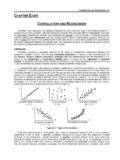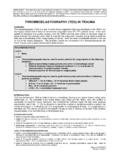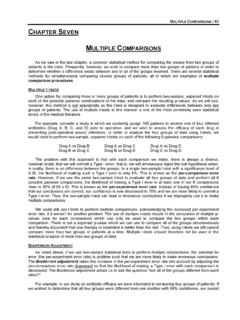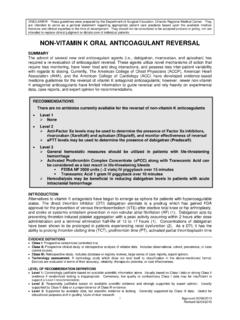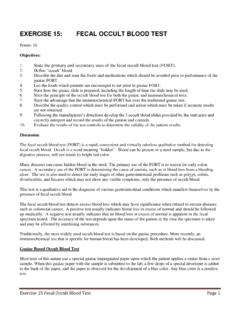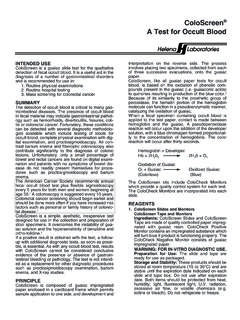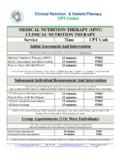Transcription of Shock: An Overview - SurgicalCriticalCare.net
1 Shock: An Overview Michael L. Cheatham, MD Ernest Block, MD Howard G. Smith, MD John T. Promes, MD Surgical Critical Care Service Department of Surgical Education Orlando Regional Medical Center Orlando, Florida Shock: An Overview Cheatham, Block, Smith, & Promes 1 Shock is one of the most frequently diagnosed, yet poorly understood clinical conditions encountered in the critically ill. The very definition of what constitutes "shock" remains controversial, largely due to its variable presentation and multifactorial etiology.
2 Ongoing investigations have identified the origins and mechanisms of the various shock states to be complex and based within the cellular foundation of normal everyday existence. Despite advances in critical care management, patients who previously would have died from their initial physiologic insult are surviving, only to succumb to the late effects of shock. Although mortality from the shock states remains high, recent advances in hemodynamic monitoring technology have significantly enhanced a clinician's ability to improve patient outcome following the development of shock.
3 DEFINITION Although early definitions of shock lack scientific terminology and reveal the inadequate understanding of pathophysiology prevalent at the time, they compensate for it in simplicity and accuracy. John Collins Warren described shock as a momentary pause in the act of death while Samuel Gross defined it as a rude unhinging of the machinery of life. With improved understanding of cellular physiology and function, we now recognize Gross' "machinery of life" to be the delivery and utilization of oxygen at the cellular level.
4 As a result, shock is currently best defined as a multifactorial syndrome resulting in inadequate tissue perfusion and cellular oxygenation affecting multiple organ systems. The importance of regional blood flow to individual organ systems is the singular concept for recognizing both the obvious and subtler shock states. Perfusion may be decreased either systemically (as in hypotension) or limited to regional maldistribution (as in septic shock, where global perfusion is normal or even elevated). Regardless of etiology or severity, all forms of shock have the commonality of perfusion inadequate to meet metabolic demands at the cellular level.
5 Decreased organ perfusion leads to tissue hypoxia, anaerobic metabolism, activation of an inflammatory cascade, and eventual vital organ dysfunction. The ultimate consequences of such malperfusion vary from patient to patient depending upon the degree and duration of hypoperfusion, the number of organ systems affected, and the presence of prior organ dysfunction. The challenge to the intensivist is identification of the hypoperfused state, quantification of its severity and prognosis, and rapid restoration of cellular perfusion to avoid organ dysfunction and failure.
6 This chapter reviews the current methods for diagnosing, monitoring, and treating the various shock states. PHYSIOLOGY Over the past decade, significant progress has been made in elucidating the cellular basis for shock. Whereas hypoperfusion and cellular ischemia were previously thought to be sufficient to cause shock, they are now recognized as being solely the initiating triggers for a complex physiologic cascade. Cellular hypoxia predisposes tissues to "reperfusion injury" leading to local vasoconstriction, thrombosis, regional malperfusion, release of superoxide radicals, and direct cellular damage.
7 Subsequent 2 Shock: An Overview Cheatham, Block, Smith, & Promes activation of neutrophils and release of proinflammatory cytokines such as tumor necrosis factor (TNF), interleukin-1 (IL-1), and platelet activating factor result in cellular injury, organ dysfunction and failure, and frequently death. Early diagnosis of cellular ischemia with prompt restoration of tissue perfusion and oxygenation is essential to preventing this inflammatory process and improving patient outcome from shock.
8 The underlying etiology may be quite evident, as in the case of upper gastrointestinal hemorrhage, or may be occult, as in the case of intra-abdominal solid viscus injury from blunt trauma. Due to the significant morbidity and mortality associated with delayed shock resuscitation, the intensivist must commonly begin appropriate management before all clinical information or diagnostic studies are available. As a result, the intensivist must possess a solid understanding of the most likely shock states, their clinical presentation, and the necessary therapeutic interventions.
9 Recognition of shock may occur through basic physical findings and physiologic measurements. Although a normal systemic blood pressure cannot be used to rule out shock, an abnormally low blood pressure may be all that is needed to document hypoperfusion and explain a patient's shock state. The presence of shock is more likely to be occult, however, and to require more indepth investigation and utilization of advanced hemodynamic monitoring techniques. Assessment of regional tissue perfusion by review of end-organ function can help to document the presence of shock before the late signs of systemic malperfusion are evident with their associated detrimental impact on patient outcome.
10 Readily identifiable clinical changes in three vital organ systems may serve to identify the presence of shock: the brain, the heart, and the kidneys. Decline in higher cortical function (mentation) may indicate diminished perfusion of the brain. This may be due to either decreased arterial blood pressure, the presence of flow-limiting lesions, or increased intracranial pressure. Although the brain can compensate to a certain degree for decreased perfusion, this ability appears to be lost when mean systemic arterial blood pressure falls below 60 to 70 mmHg (1).

